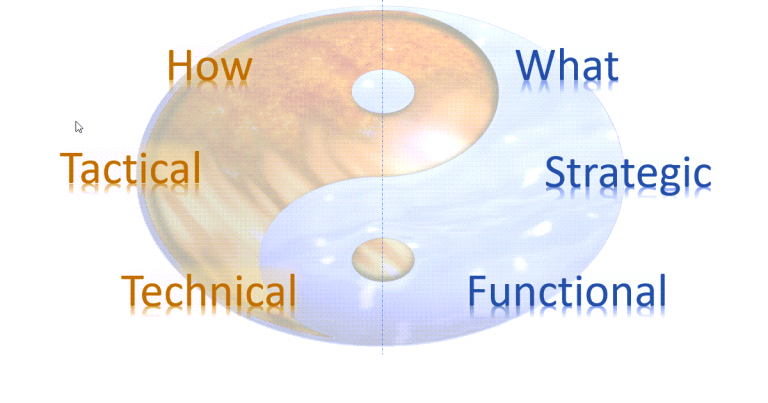How Do Startups Escape the SaaS MVP Black Hole?
This post considers the challenges that can sneak up on us when taking a minimum viable product (MVP) approach in a market space where competitor products already offer a high level of maturity. Offering too minimal of an MVP and then building user dependence on it can create unmeetable expectations that can be detrimental to our revenues, reputation, and in some cases our organizational viability.
The Spectrum between MVP and Whole-Product Thinking
MVPs provide us with a fast track to go from a new idea to working software in order to evaluate viability of a piece of functionality, employing design thinking at the feature level. This is an agile approach that delivers small increments of functionality quickly.
An approach that employs whole product thinking, on the other hand, considers a longer scope beyond the feature level and looks at the entire product solution, suite or platform, along with the capability infrastructure and long vision for future innovations.
Competing in Mature Markets and the “V” in MVP
Operating in SaaS markets that have been around for a while can be like starting a car company in the modern age. Imagine that we took an MVP approach to putting out a new car. In order to minimize cost, maximize speed and obtain feedback quickly, we put out an MVP automobile with a top speed of 30 miles per hour.
The problem with this is that table stakes in today’s market is to be able to travel at least 85 miles per hour, given the latest speed limits on major freeways. The approach results in an MVP without the V, which is just a minimum product, which lacks the viability to compete at the outset. This can result in immediate negative feedback from customers, along with expectations to bring the solution up to par.
The Point Where We Got Sucked In
As lean early-stage startups, we pride ourselves on moving fast. Often, we forgo planning beyond the sprint timebox, in terms of ~quarter-long program increments or multiyear solution road maps. Sometimes this is consciously part of our approach because we believe we can be faster-to-market without the weight of excessive process and overhead that bigger shops allegedly impose (a.k.a. avoid being big-company-stupid).

In other instances, we simply do not have the capacity in place to plan much beyond the next sprint. This could be because we have product managers who are bogged down at the team level with short-term product owner work as opposed to focusing further out. It could also be that we have nobody other than developers and engineering managers to perform the strategic alignment and foundational enabling work of enterprise architects.
Consciously or not, the lack of whole-product thinking can begin to suck us into the MVP black hole.
When Does It Become Hard to Escape?
In the car example we have going here, imagine that we need to do something about all of that negative feedback about our car that only gets up to 30 M.P.H. We ask our dev teams to increase the speed capability to 85. However, our engineers tell us that this will take longer than one sprint – way longer.
This is where we can get sucked deeper into the black hole. Imagine that we decide to appease our unhappy customers by adding quick visible value to their slow cars in the form of power steering and air conditioning, because we estimate that we can ship these things in a couple of sprints.
When we are trying to move fast and ship value quickly, we often overlook the fact that attaching other things to the engine, which is already in need of replacement, will now need to be retrofitted for the new engine when it finally gets developed. This makes the original task of overhauling the engine, which was already deemed too large to plan, even larger.
The Consequences of MVP Black Holes
If we were shipping cars, the top-speed table stakes might be obvious to us. However, in mature complex B2B market spaces like CRM, payroll, wealth management or accounting to name a few, the expected product is often not so obvious, hence the occurrence of MVP releases that are underserving. When early-stage companies lack forward-thinking agile roles, particularly in product management and enterprise architecture, I routinely observe value streaming into a black hole via the MVP mindset.
If this mindset goes unchecked, it can result in hitting a wall, such that no more incremental value that can be delivered without a major capability overhaul under the hood. A long period will inevitably follow during which little-to-no value gets delivered to the customer while focused solely on re-architecture and enabler effort. The outcome of enduring such a period can range from revenues lost to competitors to going out of business, depending on the situation.
The result of time spent in the MVP black hole can range from
D’Mention Systems, LLC
losing revenue to going out of business.
How Can We Escape MVP Black Holes?
- Reassess your market space in terms of the roles you staff. Are you in a mature B2B market space that requires enterprise architecture? If so, consider reorganizing and staffing for that role to give rise to whole-product thinking in your organization.
- Reconsider your agile approach. Are incremental MVPs proving to be too short-sighted? If so, consider an agile framework that looks out beyond the next sprint, such as SAFe Scaled Agile.
- Are your incremental releases routinely underserving customer needs? Consider whether your product management team is sufficiently focused on the customer to recognize expected product needs in your complex B2B market space. If not, you may need to staff additional roles to support them, such as product owners.
Closing
Do your budget constraints impede your capacity for enterprise architecture and strategic planning? If so, consider a staff-augmentation or fractional consulting engagement. D’Mention Systems over two decades of combined hands-on experience in the following market sectors:
- Accounting, General Ledger and Finance
- Payroll, Time, HR and Wealth Management
- Enterprise Systems for Higher Education
- Enterprise Systems for Automotive Dealerships/F&I
If you are needing to transform and scale your agile shop, please reach out – we would love to help.
Mike Liskow is a business development consultant, writer, artist, entrepreneur and thought leader in the business development space for tech startups.
D'Mention Systems was established in 2003 and provides business development consulting engagements for tech startups.





